Making Music Accessible to Knoxville Schoolchildren
Making Music Accessible to Knoxville Schoolchildren
By Laura Tenpenny (’11)
Dozens of kids wait in line impatiently to step on stage at the Sandra G. Powell Recital Hall. Many of them fidget; some bounce with excitement. When it’s their turn, each child tries out a couple different stringed instruments with the help of rental representatives tabled on stage. The kids will use their cello, violin, or other stringed instrument of choice for the duration of their lessons with the String Project, led by the Natalie L. Haslam College of Music at the University of Tennessee, Knoxville.
“My son is in his third year with the program and really benefiting from the one-on-one time with his teacher, Stephen Arthur, who tailors the cello lessons to my son’s taste in music—they are currently working on a duet version of a U2 song. Stephen is even fostering my son’s interest in composing music by sharing tips and tools for composition,” says parent, Chris Askey. “The program offers an affordable introduction to music for kids, which is especially great for kids who are trying music for the first time.”
By the end of every term, program participants will appear on this stage again—next time to perform in concert for parents, friends, and other family.
“Many students we teach have no prior musical experience, and for many, this is their first exposure to musicmaking. This presents both an incredible opportunity and responsibility to introduce them to the world of music—a task I’ve found deeply fulfilling and rewarding.”
Stephen Arthur
String Project runs first-, second-, and third-year classes on campus for Knoxville children during fall and spring semesters. The classes consist mainly of elementary-age children, with some middle school students in private, upper-level lessons. Typically, such instruction costs hundreds of dollars, but String Project offers accessible price points with UT undergraduate and graduate music students teaching classes. UT students lead classes under the guidance of two master teachers, who work outside the university as fulltime music teachers.
“Many students we teach have no prior musical experience, and for many, this is their first exposure to musicmaking,” says Stephen Arthur, a student teacher for second-and third-year classes and junior majoring in cello performance. “This presents both an incredible opportunity and responsibility to introduce them to the world of music—a task I’ve found deeply fulfilling and rewarding.”
While master teachers direct curriculum and train student teachers like Arthur, Evie Chen administrates the program as its faculty lead.
“When String Project began in 2019, only about 10 of the 25 Knoxville middle and high schools had orchestra programs, so this meets a need locally,” says Chen. “Learning strings helps kids develop confidence, persistence, and discipline. And for children who think this is something they might want to pursue professionally, it’s essential that they start learning stringed instruments early. Otherwise, it’s not a viable option for their futures. It takes years to see results compared to learning other instruments, so if you wait to start until you’re a teen, you won’t make a living from it possibly until your thirties.”
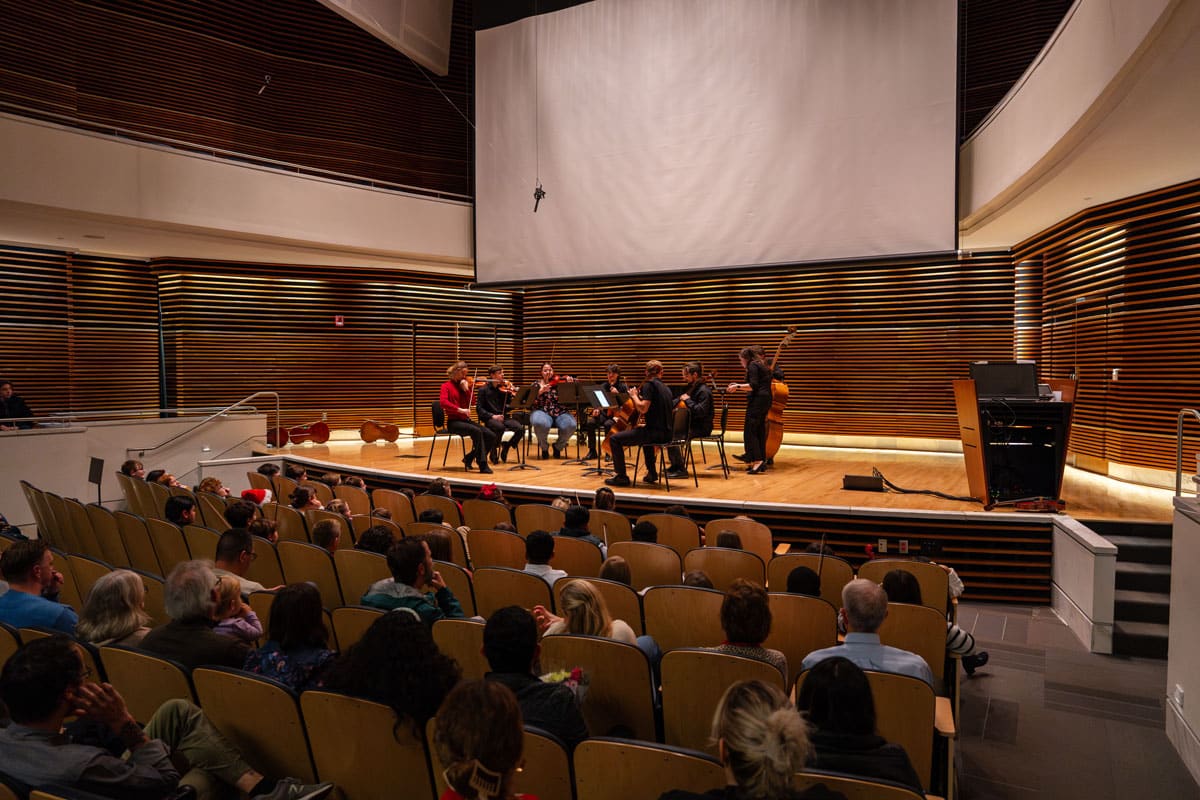
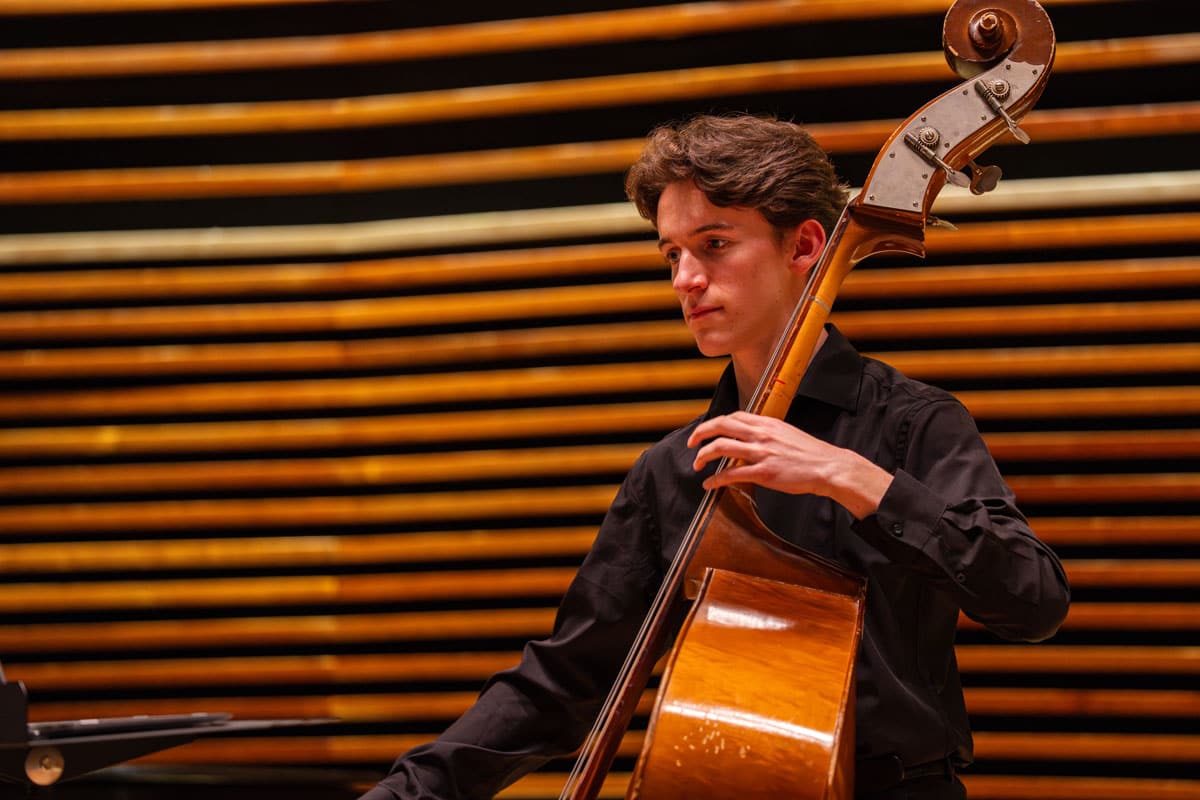
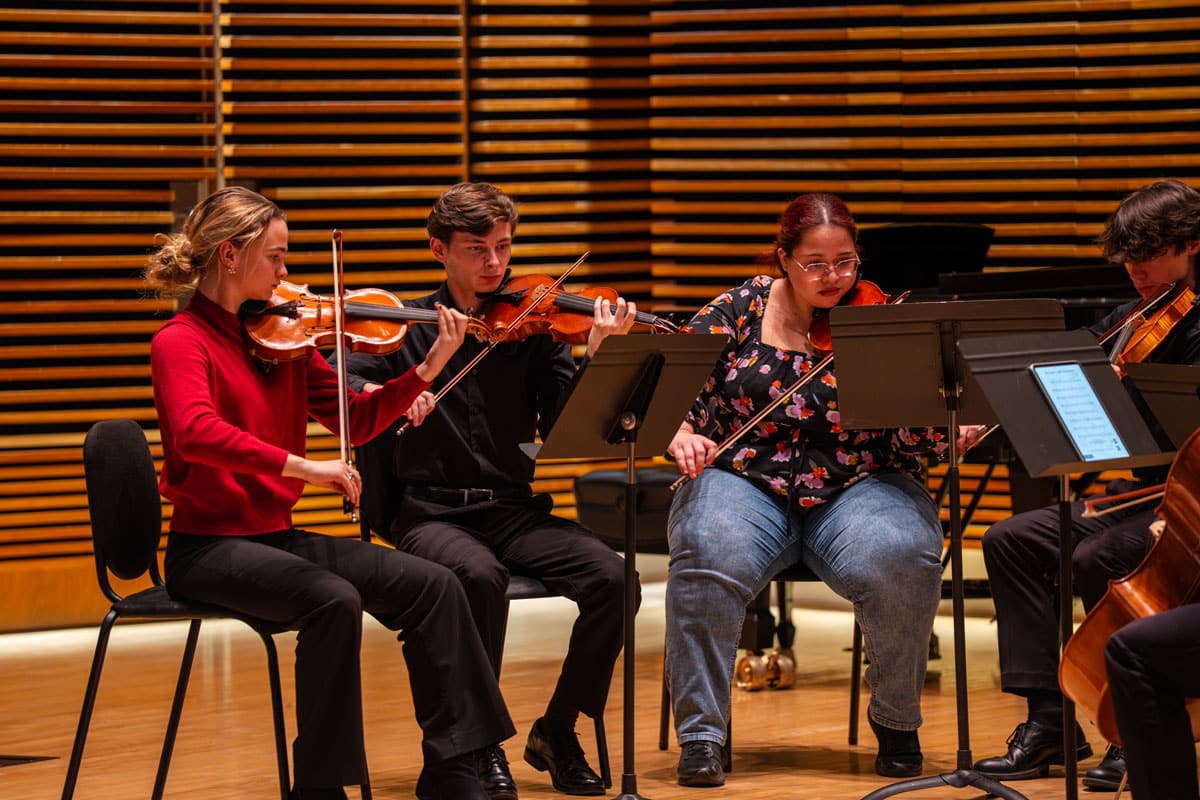
String Project student teachers performing.
Chen, lecturer of violin for the college, sees firsthand the program’s potential to build a pipeline at UT for music teachers and string musicians.
“Currently, we have about nine student teachers. We anticipate this number rising as we attract more string performance and education majors to UT,” says Chen. “I’ve seen many kids become interested in pursuing and even teaching music because of the program.”
There are String Projects across the nation at universities and colleges. UT’s began with about 15 students, funded initially through the National String Project Consortium and a grant secured through the UT Office of Research, Innovation, and Economic Development from the Tennessee Arts Commission. It has since grown to about 80 children enrolled and is sustained through the generosity of Sally and Alan Sefton, loyal donors to the college.
“Sally and I are honored to support UT’s String Project. I see it as a way of giving back,” says Alan Sefton. “My love of music started in elementary school when, as a treat, a day trip was arranged for the class to be taken to a local orchestra rehearsal. Learning about the instruments and the notes they made developed into a lifetime love of music—something that may have never occurred without this early introduction. This played a great part in my love and support of early education.”
The Seftons support the program by Donor Advised Fund every year and help bridge the gap in terms of student teacher pay, the purchase of instruments to loan to participants, and some program fee discounts for families with financial need.
“The Seftons have made music education possible for hundreds of Vols and local schoolkids,” says Chen.
For the student teachers who lead classes, this support and the real-world teaching experience it enables has given them a deeper understanding of performance and a firmer foundation for launching their professional lives.
“The organization is designed to benefit the teacher as much as the students,” explains Arthur. “While students gain from twice-weekly group classes, student teachers grow through hands-on experience in classroom management, lesson planning, and the valuable guidance of our master teachers.”
“My first day on the job, I was met with bright eyes and lightbulb moments that ignited my passion for teaching kids. This has been the most meaningful experience preparing me for life in the classroom.”
Eli Parsley
Daniel Rivera, a graduate student in music education, helps guide second-year classes as a co-master teacher for String Project and testifies to the mutual benefits for teachers and kids.
“Teaching brings you back to the basics of your instrument, and now when I play my own cello, or violin or viola, I think about the little things I tell my students: Can my right pinky do jumping jacks? Can I ring my thumb doorbell?” says Rivera, highlighting teaching methods for playing technique.
For teaching proper technique, Rivera employs an original and uniquely Southern teaching device, what he calls the “buceenham” palace.
“To make sure the left wrist doesn’t collapse, I have a small stuffed Buc-ee the Beaver that I place in their left palm. If he falls out, their wrist is not straight with their arm,” explains Rivera. “Little things like this are just really fun in the classroom and good reminders even for a university musician.”
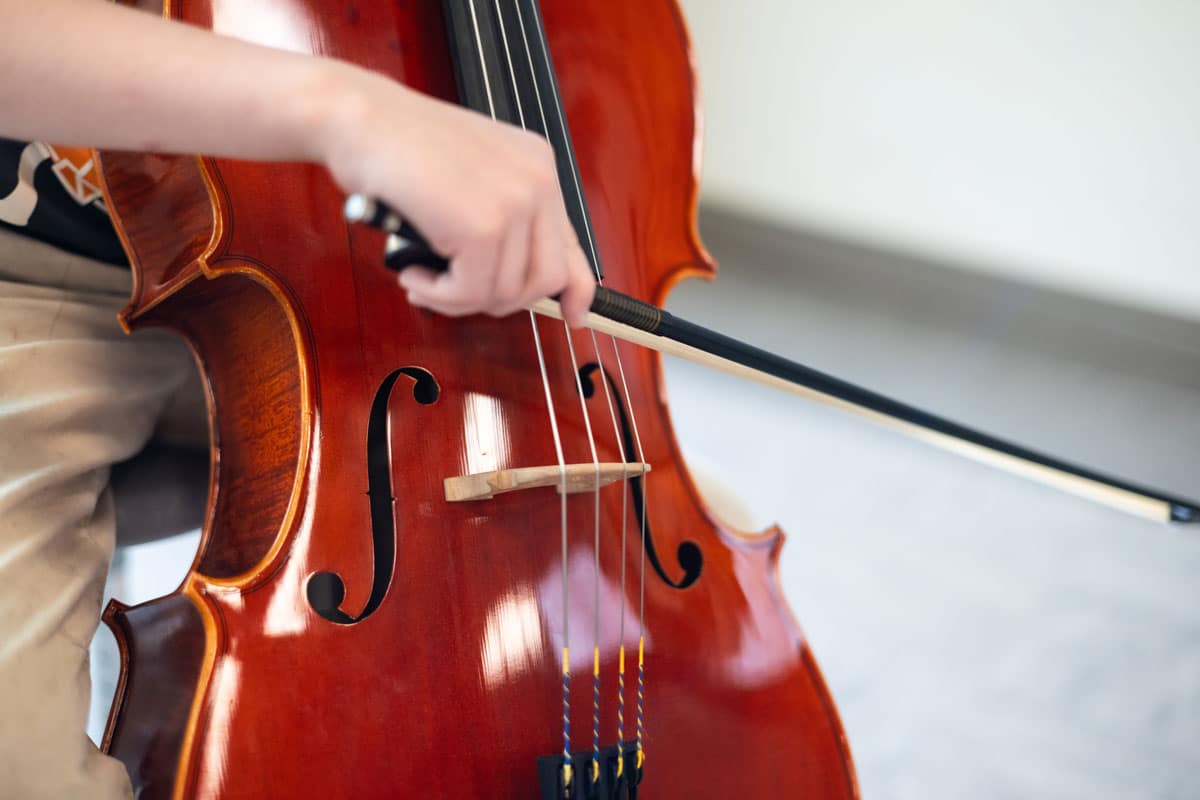
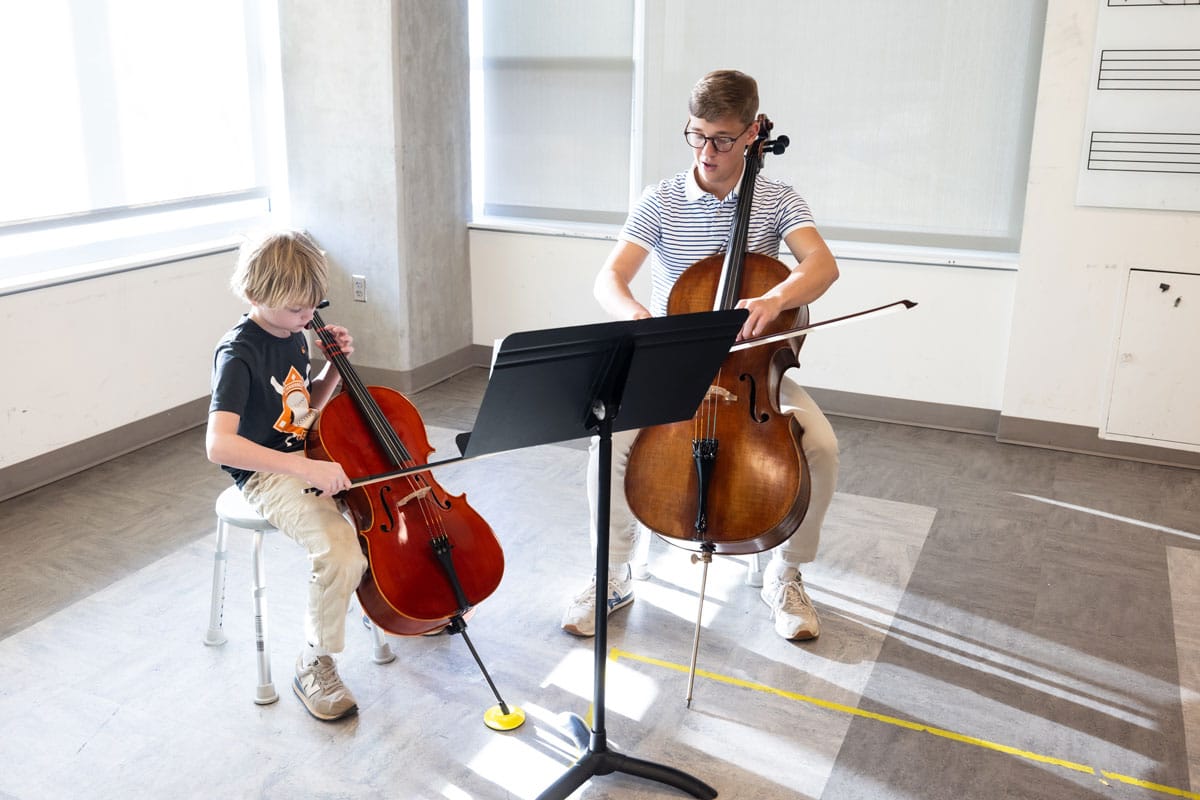
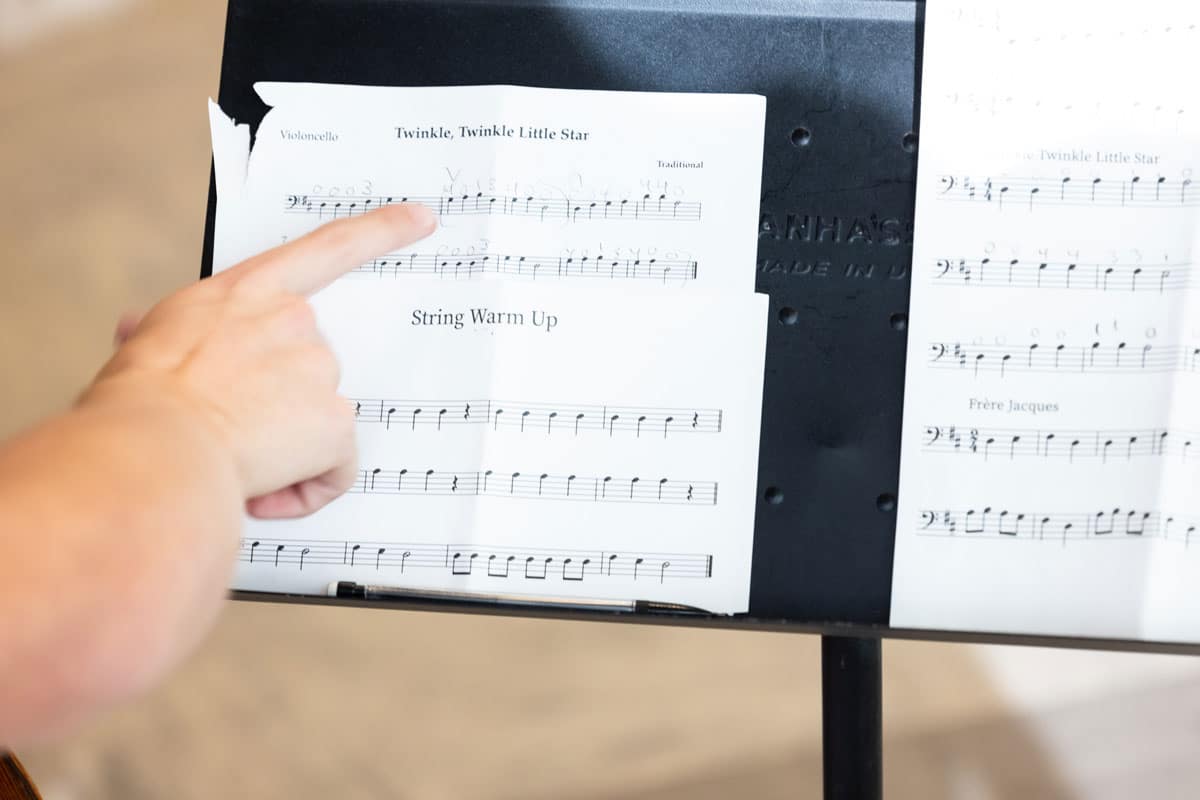
Stephen Arthur (Class of 2026) teaches one of his third-year String Project students.
With Rivera, senior Eli Parsley represents one of the few student teachers pursuing music education. With plans to teach grades 6–12 orchestra, he currently leads second-year classes.
“Students at this age are cognitively primed for learning by doing: modeling, demonstrating, singing, and call and response—all crucial tenants of effective instruction I’ve learned with String Project,” says Parsley. “My first day on the job, I was met with bright eyes and lightbulb moments that ignited my passion for teaching kids. This has been the most meaningful experience preparing me for life in the classroom.”
“Learning an instrument is no easy task, and many students face frustration when things get tough. However, when we do our job well, these students push past challenges and feel a deep sense of pride as they reflect on how far they’ve come.”
Stephen Arthur
While Arthur does not share Parsley’s pedagogical aspirations—he plans to perform professionally in a symphony orchestra and keep a private studio—the difference that he and each student teacher has made in their students’ lives unifies their experiences.
“The greatest reward of teaching for String Project is witnessing and being part of the sense of accomplishment our students feel at the end of each semester,” says Arthur. “In just four months, they go from not even knowing the name of their instrument to reading music and playing several pieces. Learning an instrument is no easy task, and many students face frustration when things get tough. However, when we do our job well, these students push past challenges and feel a deep sense of pride as they reflect on how far they’ve come.”
Each term’s concluding concert serves as an exclamation point to the semester’s lessons, emphasizing the growth of each student playing on stage, where only a few months prior many of them first held their instrument.
One day, some of these participants might choose to return to that same stage…as Volunteers pursuing careers in string music.

